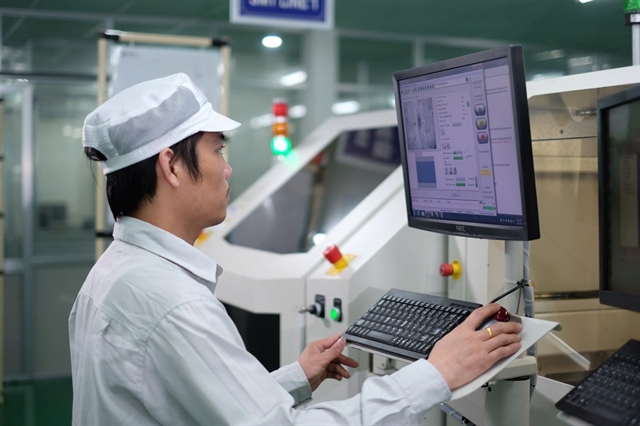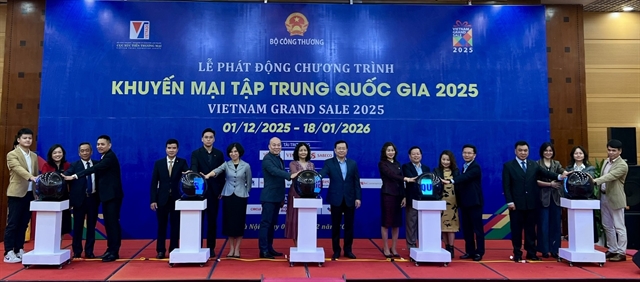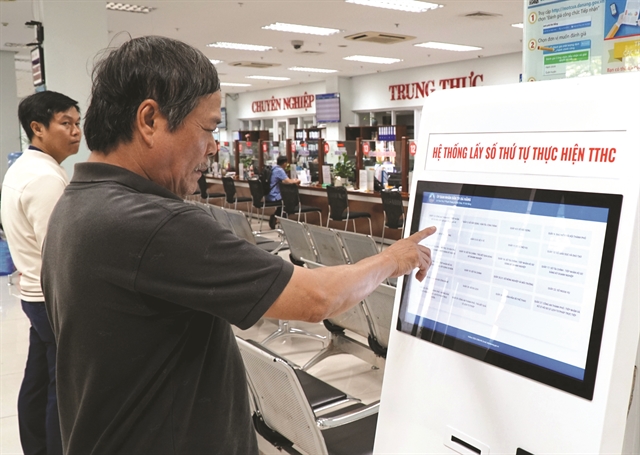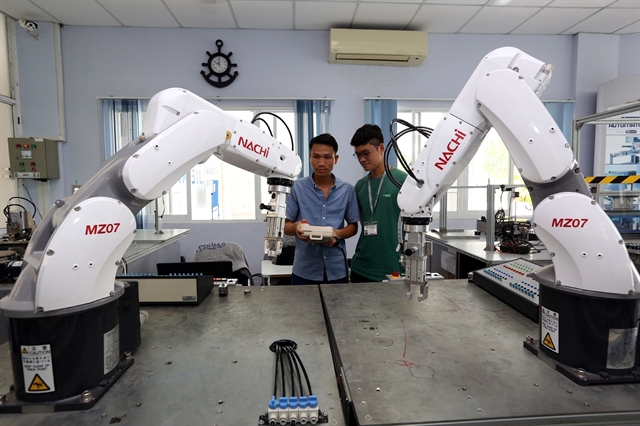 Society
Society

| Việt Nam is set to develop its semiconductor industry, with the involvement of numerous leading global technology corporations. VNA/VNS Photo |
The Việt Nam Communist Party in December last year issued a resolution on making breakthroughs in science, technology, innovation, and digital transformation development in the country (or Resolution 57 for short).
The resolution lays a roadmap to dismantle institutional constraints, modernise digital infrastructure, elevate human capital, strengthen enterprise-led innovation, and transform public governance through technology. Across five key pillars, the country is laying the foundation for sustainable and inclusive digital growth.
Removing institutional bottlenecks
Việt Nam has long regarded science and technology as vital drivers of national development. The resolution on science and technology development adopted by the Party Central Committee in 2012, and the Law on Science and Technology passed by the National Assembly in 2013 were important foundations for modernising the legal framework. However, administrative hurdles and regulatory fragmentation have continued to hinder the practical application of scientific breakthroughs.
Associate Professor Chu Hoàng Hà, vice president of the Việt Nam Academy of Science and Technology, pointed out a paradox: despite holding more than 300 intellectual property rights, including many international patents, the academy’s research often fails to reach the market due to legal inconsistencies. Conflicting regulations across multiple laws—governing science, public officials, public assets, the state budget, and investment—create a maze for researchers and institutions.
He cited the example of a genetically edited soybean variety capable of producing oil with similar properties to olive oil. Although Vietnamese researchers achieved results comparable to those in the US and China, licensing was blocked due to the absence of a supporting legal framework.
“We need legislative reform that gives priority to applying domestic technologies. This would not only recognise the value of Vietnamese research but also drive development,” said Hà.
Professor Nguyễn Anh Trí, former director of the National Institute of Haematology and Blood Transfusion, echoed these concerns. His team developed a red blood cell panel tailored to Vietnamese physiology—superior to imported versions and more cost-effective—yet commercialisation remains out of reach due to licensing issues. The innovation is currently used only within the institute, despite its broader potential.
Trần Thị Nhị Hà, deputy head of the National Assembly’s Committee for People’s Aspirations, emphasised the fragmented and slow-moving legal system governing technological products. Scientific innovations across various sectors—from healthcare to renewable energy—must often be approved by multiple ministries, causing delays or dead ends. In one case, a single AI-powered medical product had to be registered with both the Ministry of Health and the Ministry of Information and Communications.
To address this, she proposed a unified and streamlined licensing regime. She also suggested capping patent approval timelines at three years, with a 12-month limit for substantive examination—ensuring research can move more quickly from lab to life.
The NA passed a resolution in February 2025 on piloting several policies to create in national digital transformation. It introduces a pilot mechanism to implement Resolution 57, featuring bold provisions such as lump-sum budgeting for research, granting researchers rights to manage their outputs and equipment, supporting commercialisation, and central funding for digital infrastructure. The NA resolution aims to cut red tape and allow scientists to focus on innovation.
An amended Law on Science, Technology and Innovation is expected to be submitted to the National Assembly in May 2025. At the same time, a 2026–2030 Science and Technology Strategy is being developed to guide long-term planning.
Investing in digital infrastructure
 |
| VNPT Group deploys the installation of VinaPhone 5G infrastructure and transmission stations nationwide. As one of the pillars of the fourth Industrial Revolution, digital infrastructure, including the 5G network, has a profound impact on socio-economic development by driving innovation and increasing productivity in various sectors.VNA Photo |
If institutions form the skeleton of reform, then digital infrastructure is its nervous system. Fast, reliable, and inclusive connectivity is essential to both digital transformation and the application of scientific progress.
In Hữu Liên Commune, Lạng Sơn Province, remote hamlets like Nà Nọoc and Lân Đặt were once beyond the reach of mobile networks and electricity. Local residents often trekked through the forest for half a day just to receive official announcements. By 2023, Nà Nọoc had been connected to the national grid and gained limited mobile signal, replacing paper trails with phone calls and emails.
 |
| People take a queue number to carry out administrative procedures. |
In Lân Đặt, where signal remains weak, even a single mobile phone hung from a rooftop—dubbed the “rooftop phone”—has revolutionised local communication. Meanwhile, in more central hamlets, digital tools have gone further. With 4G and fibre-optic internet in place, a Youth Union-led digital task force was formed in 2021 to promote awareness and usage.
The campaign gained momentum in 2022. Through social media platforms like Facebook, Zalo and TikTok, Hữu Liên’s scenic beauty was widely shared, attracting tourists to the Đồng Lâm grasslands.
Hoàng Vũ, Youth Union secretary of Hữu Liên Commune, who also runs a homestay, took advantage of online booking, e-payments and digital marketing to grow his business to 120 guests per month, earning nearly VNĐ50 million in monthly revenue.
Inspired by this success, the commune set up digital teams in each village, focusing on e-commerce, public services, and community engagement via apps like “Xứ Lạng Digital Citizen”. These are not isolated gains—they show how digital infrastructure can transform rural communities.
Nationally, Việt Nam has reached 99.8 per cent 4G coverage since rollout began in 2017. The next target is 5G. To speed up deployment, the Government will subsidise 15 per cent of telecom companies’ investment costs if they install at least 20,000 5G stations in 2025. The aim is to bring 5G access to all cities and provinces.
According to Rita Mokbel, chairwoman of Ericsson Việt Nam, 5G is vital for industrial automation, smart cities, and achieving a digital economy contributing 20 per cent of GDP by 2025.
Currently, internet bandwidth relies on just six undersea cable systems. The NA February resolution aims to address this by allowing domestic companies to invest in new infrastructure through direct appointments or international partnerships.
To support this vision, Prime Minister Phạm Minh Chính on March 1 signed a directive, prioritising 5G and high-speed broadband as key to economic modernisation.
Developing human resources
Digital transformation also depends on human capital. Việt Nam’s long-term development strategy hinges on cultivating a high-quality, innovative and adaptable workforce.
The country has over 240 universities, with 160 offering science and engineering degrees. STEM students make up about a third of all undergraduates—some 560,000 to 600,000.
 |
Students practise programming and operating robots at the Training Centre of the Hồ Chí Minh City High-Tech Park. The centre collaborates with high-tech enterprises and universities and colleges to offer training courses for engineers in specialised high-tech fields. VNA/VNS Photo |
Deputy Education and Training Minister Hoàng Minh Sơn highlighted the importance of integrating research and education. “When universities combine training with applied research, they not only enhance teaching quality but also produce meaningful scientific results,” he said.
Curricula are being updated, and talent development programmes are in place across undergraduate, master’s, and doctoral levels. A 2025–2035 national human resources training plan is currently under review by the Prime Minister.
Major universities are aligning their strategies with Resolution 57. Professor Lê Anh Tuấn, council chairman at Hanoi University of Science and Technology, said: “Talent is at the core of our growth strategy. Our thematic resolution and action plan focus on attracting and retaining top-tier researchers.”
Việt Nam National University in HCM City is also working to attract young scientists. Associate Professor Vũ Hải Quân, director of the university, said their “VNU350” programme had recruited 27 young PhDs so far, including seven from top 100 global universities.
The university was also building a digital governance system to enhance transparency in approving and reporting research.
Professor Chử Đức Trình, rector of the University of Engineering and Technology under Hà Nội National University, said full autonomy over the past three years allowed them to implement stronger support for research groups. Department heads were now empowered to set scientific goals and manage research funding, creating a strong research culture from undergraduate to doctoral levels.
Enterprises at the forefront
The commercialisation of science and technology relies heavily on enterprises, especially large firms that adopt new technologies and lead in digital transformation.
The Rạng Đông Light Source and Vacuum Flask JSC, for example, has embraced automation and digital systems since 2020, transforming into a modern and eco-friendly manufacturer.
Đào Văn Phú, deputy head of Systems and IT of Rạng Đông, said robotic integration had raised productivity by 30 per cent to 7.5 million units per month.
Deputy General Director Nguyễn Đoàn Kết said: “In the digital age, standing still means falling behind. Digital transformation has helped us maintain 15–20 per cent annual growth.”
Rạng Đông aims to complete its transformation by 2025, with a vision of becoming a billion-dollar enterprise by 2030.
CMC Corporation is also pushing ahead with artificial intelligence. Nguyễn Trung Chính, chairman of the corporation, said: “Since 2016, we’ve focused on AI. Our ‘Enable Your AI-X’ strategy targets a workforce where 40 per cent are AI specialists, with projected revenue surpassing US$1 billion by 2030.”
The 2025 Việt Nam National Forum on Digital Enterprises underlined the Government’s ambition—under Resolution 57—to establish major digital technology firms by 2025.
Minister of Science and Technology Nguyễn Mạnh Hùng said: “For Việt Nam to make real strides in science, technology and innovation, large enterprises must take the lead—supported by clear policy missions.”
Enhancing public policy and administration
Technology is not only reshaping business—it is also transforming public administration. Digital services improve efficiency, reduce costs, and make government more accessible to citizens.
Nguyễn Vân, a resident at Song Phượng Commune in Hà Nội's suburban district of Đan Phượng recently applied for a replacement marriage certificate online and received it by post, saving significant time and effort. In Song Phượng Commune, local officials are encouraging online services through QR codes and community outreach, although many residents still prefer in-person visits.
To boost adoption, Hà Nội has launched digital support desks at post offices and telecom outlets to help older citizens and those less familiar with online systems. These initiatives aim to achieve the “3 NOs”: no boundaries, no intermediaries, and no paperwork.
At present, only 46 per cent of public service applications are fully online. While ministries average 64 per cent, local levels trail at just 18 per cent. Some provinces are offering fee waivers or faster processing to encourage digital use.
Enterprises, too, are calling for administrative reform. CMC Chairman Chính said construction approval for one of their complexes had been delayed by three years—an example of the need to streamline processes.
Recent breakthroughs are encouraging. From July 2024, citizens can now complete procedures such as birth registration and death certification through an integrated online portal—formerly a six-agency process.
Looking ahead, the Government’s 2025 Administrative Procedure Reform Plan aims to reduce costs and processing times by 30 per cent, eliminate outdated business conditions, and shift all enterprise-related services online.
Deputy Minister of Science and Technology Phạm Đức Long confirmed that enhancing digital governance would be a top priority. The Việt Nam Internet Association also sees it as key to creating a smaller, more efficient state apparatus.
Resolution 57 is not just a policy—it is a comprehensive vision for Việt Nam’s digital future. By removing institutional barriers, investing in infrastructure, developing talent, empowering businesses, and modernising governance, the country is positioning itself to lead in global innovation.
The road ahead requires bold reforms and cross-sector cooperation. But the momentum is strong—and so is the opportunity. With Resolution 57 as a guide, Việt Nam is accelerating into a future shaped by science, powered by technology, and driven by its people. VNS




